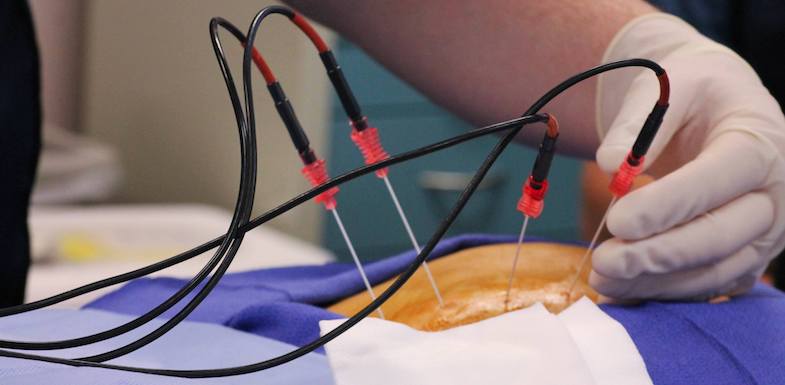
Different radio frequency procedures are essential in pain management. It is the best form of treatment for trigeminal neuralgia, different types of cancer pain and spinal pain including low back and neck pain.
There are two types of Radio Frequency pain management procedures. The older one is Conventional Radio Frequency where heat is generated which is producing the lesion and stopping the pain signal. The newer one is Pulsed Radio Frequency where a strong electro-magnetic field is produced around the nerve which is stopping the pain signal. Here the normal function of nerve is maintained and only abnormal pain is stopped.
Radio Frequency (RF) lesioning involves passage of a very high frequency current through a 27 G thermocouple probe. This probe is passed through a 20/22G cannula (a kind of needle), which is insulated except at its tip. When a high frequency alternating current is passed (at 300 kHz) through the RF thermocouple probe the charged ions in the human tissue around the exposed tip of RF cannula moves to & fro. This produces electro-mechanical friction and thus heat is generated. The thermocouple probe is not heated itself, it actually dissipates the heat generated at the surrounded tissue. Thus the heat is totally controlled by the operator. The lesion generated is shaped like a matchstick head with a diameter of 2-4mm. Beyond this distance; electrical field is weaker as it is dispersed, so no lesion is produced.
The temperature & therefore the heat lesion is maximum around the shaft and minimum at its tip. On the other hand the electrical field generated is maximum at its tip and minimum around the shaft. In the conventional RF rhizotomy type we are producing heat lesion. In the pulsed RF electrical field is producing the lesion. In pulsed RF temperature is not raised beyond 42-degree C. Electrical field produces some punch in the capacitor of small diameter nociceptive (pain transmitting) fibers. Thereby signal transmission through this fibre is stopped.
In the conventional type the nerves are regenerated in future & average pain-free period varies for type of nerve. In a properly performed lesion pain free period is 3-4 years. In the pulsed RF the average pain free period is 4-24 months.
The conventional RF rhizotomy is done at sympathetic ganglions, and at purely/ predominantly sensory nerves. It is always avoided in mixed or predominantly motor nerves. Before doing actual lesioning radiological and electrical tests are done to keep the probe away from these nerves in conventional RF lesioning. The commonly performed conventional RF rhizotomy procedures are at following nerves.
1)Trigeminal (Gasserian) ganglion and its divisions i.e. mandibular nerve & maxillary nerve.,
2)Stellate ganglion,
3)Cervical facet joint medial branch
4) Thoracic facet joint medial branch
5) Splanchnic nerves
6. Lumber sympathetic plexus
7. Superior Hypogastric plexus
8. Lumber facet joint medial branch
9. Sacro-Iliac joint supplying nerves
In Pulsed RF as there is no heat lesioning it is safe to perform it in most kinds of nerves. It is mostly effective in nerve ganglions but also effective trunks. It may be performed in all the above procedures except trigeminal ganglion. It is mainly indicated in Dorsal root ganglionostomy. It is also done in mixed peripheral nerves like suprascapular nerve.
